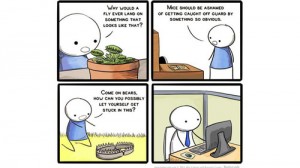Every Monday from April to June, the GATA Network will be sharing advice on how to make your summer productive. This week we offer our suggestions on how to improve your working quarters (or go about making some).
For decades, scholarship on teaching and learning has suggested that educational spaces need more attention. For instance, Mauk (2006) argues that “buildings constitute beliefs about appropriate practices” (218). The power of any environment to condition and influence learning, for better or for worse, is recognized in thoughtful classroom design, instructional strategies, and a number of other educational choices. But doesn’t that power also apply to our workspaces as student teachers, too?
Much has been written about (read: griped about) the office conditions of the average GA/TA. More often than not, student teachers and research assistants are huddled into shared offices, lacking windows, under staircases, Harry Potter style. Some of us don’t even have offices. Others have offices that feel like crowded dungeons. Both are equally depressing, but there are ways to improve them. A long line of GA/TAs before you have figured out how to make these spaces work (or find spaces to do work).
This isn’t the first time the Network has taken up the ergonomics flag. No doubt you all took our advice months ago and modernized your office. Even so, the following bears some repeating:
Convert to the standing desk. Researchers argue that there are multiple potential benefits to converting your desk into a standing desk, including potential health benefits and a 10% boost in productivity. Most importantly, it’s relatively inexpensive to convert.
Try the exercise ball chair. As we warned before, the jury is still out on whether these chairs solve more problems than they cause. Educate your self on the pros and cons and determine whether core-work at work is right for you.
Have you jazzed-up your cubicle yet? Because we’re assuming your “office” is actually a cubicle, and everyone knows cubicles are the worst. Melanie Pinola has some interesting recommendations. Like have you thought about bringing your own furniture?
Other office hacks. Ilya Pozin’s list of little things you can do to make your office better, entitled “25 Office Hacks You Need To Know“, is still the best list of office hacks we’ve seen.
But what about those of us that don’t even have a cubicle to call our own? Or what about those of us looking for an office on the go? You can find a workspace that works for you just about anywhere you are if you consider the following.
The Coffee Shop: A Scholar’s Temporary Office
All this advice on how to spruce up your office is useless if you don’t have one, or if the office is beyond saving. In such cases, your local coffee shop will do. We’re not suggesting you become one of those phonies that they make fun of on Family Guy – the type that sits in a café all day with their computer under the pretense that they are doing real “work” when they actually aren’t. The thing to note here is that cafés are, for all intents and purposes, quite serviceable as temporary offices. Buying a coffee is essentially like renting space here. Some people even find they are more productive working in caffeine emporiums. Note: Here at UWindsor, the Green Bean Café sells bottomless coffee. Bottomless. Coffee.
The App Crowd: Creating Office Ambiance
Maybe you want the café feel without going to the café? It turns out there’s a website called Coffitivity that streams coffee shop background noises on a continuous loop for those of you that feel you work better amid that unique type of chatter. Add that to soundrown, the ambient noise app we’ve discussed here before (which also has a coffee house option), and you’ll have the right soundtrack for any GA/TA office mood.
Mauk, J. (2006). “Location, location, location: The “real” (e)states of being, writing, and thinking in composition. In P. Vandenberg, S. Hum, and J. Clary-Lemon (Eds), Relations, locations, positions: Composition theory for writing teachers. (pp.198-225). Urbana, Il: NCTE.




Recent Comments